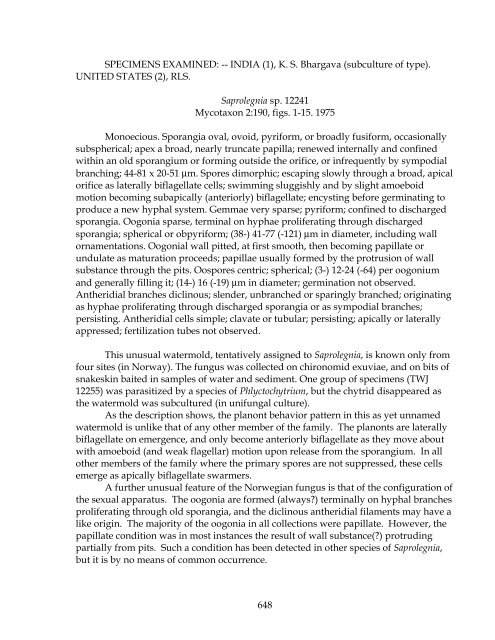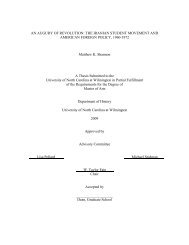Saprolegnia - The iLumina Digital Library
Saprolegnia - The iLumina Digital Library
Saprolegnia - The iLumina Digital Library
You also want an ePaper? Increase the reach of your titles
YUMPU automatically turns print PDFs into web optimized ePapers that Google loves.
SPECIMENS EXAMINED: -- INDIA (1), K. S. Bhargava (subculture of type).<br />
UNITED STATES (2), RLS.<br />
<strong>Saprolegnia</strong> sp. 12241<br />
Mycotaxon 2:190, figs. 1-15. 1975<br />
Monoecious. Sporangia oval, ovoid, pyriform, or broadly fusiform, occasionally<br />
subspherical; apex a broad, nearly truncate papilla; renewed internally and confined<br />
within an old sporangium or forming outside the orifice, or infrequently by sympodial<br />
branching; 44-81 x 20-51 µm. Spores dimorphic; escaping slowly through a broad, apical<br />
orifice as laterally biflagellate cells; swimming sluggishly and by slight amoeboid<br />
motion becoming subapically (anteriorly) biflagellate; encysting before germinating to<br />
produce a new hyphal system. Gemmae very sparse; pyriform; confined to discharged<br />
sporangia. Oogonia sparse, terminal on hyphae proliferating through discharged<br />
sporangia; spherical or obpyriform; (38-) 41-77 (-121) µm in diameter, including wall<br />
ornamentations. Oogonial wall pitted, at first smooth, then becoming papillate or<br />
undulate as maturation proceeds; papillae usually formed by the protrusion of wall<br />
substance through the pits. Oospores centric; spherical; (3-) 12-24 (-64) per oogonium<br />
and generally filling it; (14-) 16 (-19) µm in diameter; germination not observed.<br />
Antheridial branches diclinous; slender, unbranched or sparingly branched; originating<br />
as hyphae proliferating through discharged sporangia or as sympodial branches;<br />
persisting. Antheridial cells simple; clavate or tubular; persisting; apically or laterally<br />
appressed; fertilization tubes not observed.<br />
This unusual watermold, tentatively assigned to <strong>Saprolegnia</strong>, is known only from<br />
four sites (in Norway). <strong>The</strong> fungus was collected on chironomid exuviae, and on bits of<br />
snakeskin baited in samples of water and sediment. One group of specimens (TWJ<br />
12255) was parasitized by a species of Phlyctochytrium, but the chytrid disappeared as<br />
the watermold was subcultured (in unifungal culture).<br />
As the description shows, the planont behavior pattern in this as yet unnamed<br />
watermold is unlike that of any other member of the family. <strong>The</strong> planonts are laterally<br />
biflagellate on emergence, and only become anteriorly biflagellate as they move about<br />
with amoeboid (and weak flagellar) motion upon release from the sporangium. In all<br />
other members of the family where the primary spores are not suppressed, these cells<br />
emerge as apically biflagellate swarmers.<br />
A further unusual feature of the Norwegian fungus is that of the configuration of<br />
the sexual apparatus. <strong>The</strong> oogonia are formed (always) terminally on hyphal branches<br />
proliferating through old sporangia, and the diclinous antheridial filaments may have a<br />
like origin. <strong>The</strong> majority of the oogonia in all collections were papillate. However, the<br />
papillate condition was in most instances the result of wall substance() protruding<br />
partially from pits. Such a condition has been detected in other species of <strong>Saprolegnia</strong>,<br />
but it is by no means of common occurrence.<br />
648
















